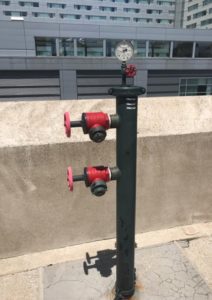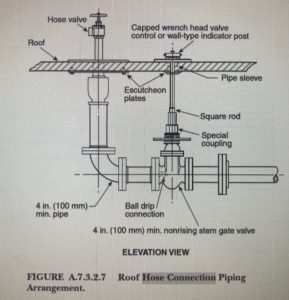Up On The Roof

 We often encounter areas within the codes and standards that need interpretation. The National Fire Sprinkler Association’s Expert of the Day (EOD) program is a benefit that strives to help our members with technical responses to codes and standards questions for requirements pertaining to water-based fire protection. The EOD program has subject matter experts (SME) across the Codes, Standards and Public Fire Protection, Engineering, and Contractor Services departments available to provide informal interpretations.
We often encounter areas within the codes and standards that need interpretation. The National Fire Sprinkler Association’s Expert of the Day (EOD) program is a benefit that strives to help our members with technical responses to codes and standards questions for requirements pertaining to water-based fire protection. The EOD program has subject matter experts (SME) across the Codes, Standards and Public Fire Protection, Engineering, and Contractor Services departments available to provide informal interpretations.
The standpipe roof hose connection is an example of an often debated and misunderstood section found in earlier editions of NFPA 14 Standard for the Installation of Standpipes and Hose Systems. NFSA has answered the following questions many times over the years as a part of the EOD program. What is the intended purpose of the roof hose connection? When is it required to be installed?
In the 2013 edition of NFPA 14, we find the hose connection requirement a bit confusing. Section 7.3.2 states that a hose connection is required “at the highest landing of stairways with stairway access to a roof, or on roofs with a slope of less than 4 in 12 where stairways do not access the roof.
7.3.2* Class I Systems. Class I systems shall be provided with 2 ½ in. hose connections in the following locations.
1. At the main floor landing in exit stairways
2. On each side of a wall adjacent to the exit openings of horizontal exits
3. In other than covered mall buildings, in each exit passageway at the entrance from the building areas into the passageway
4. In covered mall buildings, at the entrance to each exit passageway or exit corridors, and at the interior side of public entrances from the exterior to the mall
5. At the highest landing of stairways with stairway access to a roof, or on roofs with a slope of less than 4 in 12 where stairways do not access the roof
A7.3.2(5) Access to the roof can be via stairwell that terminates at the roof level. Access could also be a permanent ladder, permanent ladder rungs, or a pull-down stair with a roof hatch.
Does the “stairway access” to a roof indicate the need for stairs that access the roof, or does it simply indicate access from the stairway? This has been debated and misapplied for many years. The annex note found in that edition gives good examples to what is acceptable access. The intent becomes clearer in the 2019 edition of NFPA 14 with the separation of this section along with that annex note to help the designer understand the term “access to a roof.”
These simple changes noted helps to clarify the access but does not address the use of the roof hose connection directly. It is clear by the exemptions that the purpose of this hose valve is to allow a minimal supply to the unoccupied roof and allow for standpipe testing. When required, the roof hose connection can be singular, not required to meet travel distance requirements and can have a control valve installed to prevent freezing.
7.3.2.9.2.1 Where there are no hose connections as provided by 7.3.2.9.2, a single hose connection shall be provided on the roof
7.3.2.11.3 The distance in 7.3.2.10 and 7.3.2.11 shall not apply to the roof if the roof is not intended for occupancy
5.2.3.5.1 System water control valves and supply pipes shall be protected against freezing and mechanical injury
Figure A.7.3.2.7 Courtesy of NFPA

These are all indicators that while it will provide system demand and can be used for fire department operations it also allows for an easy location for system flow testing.
Visit NFSA’s TechNotes for more information of the EOD Program and the SMEs that answers them.
